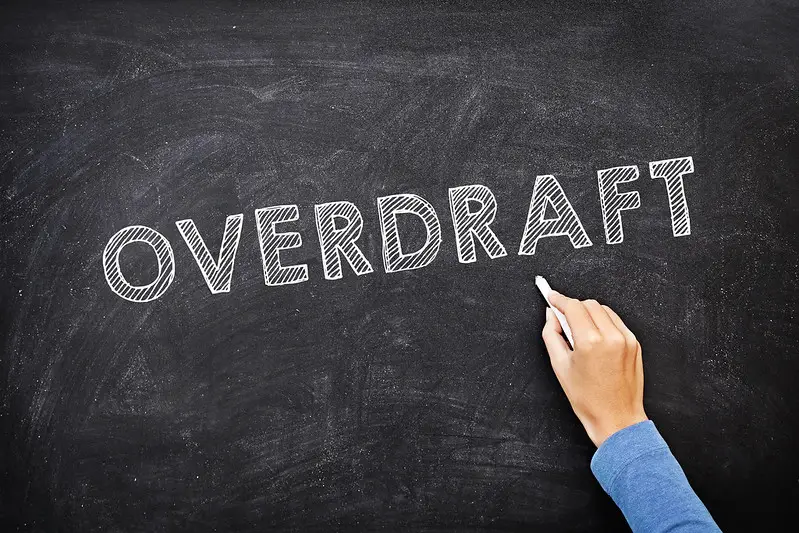Both overdraft and cash credit are types of short-term loans that can help you manage your cash flow requirements. Overdrafts allow you to borrow money overdrawn from your current account up to a certain limit, whereas cash credit provides a revolving line of credit against collateral.
Overdraft
(Photo By Mike Cohen on Flickr)

Overdraft is a credit facility offered by banks to their customers. It allows them to withdraw funds from their accounts even when there’s no balance in it, up to an agreed limit. The overdraft limit is determined based on the customer’s credit history and income.
The primary advantage of an overdraft facility is that it provides flexibility to account holders, especially during emergencies or unforeseen circumstances. For instance, if you have bills due but are waiting for your salary payment, you can use your overdraft facility temporarily without worrying about bounced cheques or declined transactions.
However, one major disadvantage of overdrafts is that they often come with high-interest rates and additional fees such as maintenance charges and processing fees. Therefore, it’s essential only to use this facility when required and pay off the outstanding amount promptly.
There are two types of overdraft facilities: secured and unsecured overdrafts. Secured overdrafts require collateral while unsecured ones don’t need any security deposit or guarantee from the borrower.
While Overdraft may be helpful at times of financial crises if used responsibly; its interest rates should be considered carefully before deciding whether to opt for this service or not.
Cash Credit
(Photo by engin akyurt on Unsplash )

Cash credit is a type of loan that allows borrowers to withdraw money up to their approved credit limit. It is usually granted for short-term financing needs, such as inventory purchases or paying suppliers. The interest rate for cash credit is typically lower than other forms of unsecured loans like personal loans because it requires collateral.
One of the advantages of cash credit is its flexibility. Borrowers have access to funds whenever they need them and can repay the borrowed amount at any time without incurring pre-payment penalties. This makes it an ideal option for businesses with fluctuating cash flows.
However, one disadvantage of cash credit is that it requires collateral, which means that borrowers must provide security in the form of assets like inventory or accounts receivable. In case they are unable to repay the loan, lenders will seize these assets as compensation.
Another potential downside of cash credit is that interest rates may vary depending on market conditions and borrower risk profiles. This means that borrowers may end up paying higher interest rates if there’s a sudden shift in economic conditions or if their financial situation deteriorates.
While there are some drawbacks associated with cash credit, it remains a useful financing tool for many small business owners who require flexible funding options backed by collateral.
Overdraft Vs. Cash Credit – Key differences
Overdraft and cash credit are both financial products offered by banks to meet the short-term funding requirements of businesses. However, these two facilities differ in several ways.
Firstly, overdraft is a facility where the bank allows a business to withdraw more money from its account than what is available in it up to an agreed limit. On the other hand, cash credit is a revolving loan facility where the bank provides funds against hypothecation or pledge of stocks or receivables.
Secondly, an overdraft can be either secured or unsecured while cash credit always requires collateral. Banks may demand security for any amount sanctioned over and above a certain limit if it’s not under their comfort level.
Thirdly, interest rates on overdrafts are charged only on amounts withdrawn from the account whereas interest on cash credit loans applies to the entire sanctioned amount regardless of how much has been utilized.
Repayment terms vary significantly between these two facilities with overdraft being repayable usually within 12 months while Cash Credit limits have higher tenure like 3 years which makes them suitable for longer term working capital requirements.
What are the advantages and disadvantages of cash credit?
Cash credit is a type of loan that allows businesses to withdraw funds from their bank account up to a certain limit. While cash credit can be an effective way for businesses to manage their working capital, it also comes with its own set of advantages and disadvantages.
One advantage of cash credit is that it provides quick access to funds when needed. Businesses can withdraw the amount they need at any time, without having to go through additional paperwork or approval processes. This makes it easier for them to meet short-term financial requirements such as paying salaries or purchasing inventory.
Another advantage of cash credit is that interest rates are generally lower than other types of loans, making it a cost-effective option for managing working capital. Additionally, since the interest rate is charged only on the outstanding balance, borrowers have greater control over how much they pay in interest.
However, there are also some disadvantages associated with cash credit. One disadvantage is that the repayment terms may not be flexible enough for all businesses. Lenders often require regular payments based on a fixed schedule which may not always align with the borrower’s revenue stream.
Furthermore, borrowing too much through cash credits could lead some companies into debt traps if payment obligations cannot be met and debts pile up over time leading ultimately bankruptcy
While there are both pros and cons associated with using cash credit as a financing tool – ultimately whether this method suits your business will depend upon your specific needs and circumstances
What are the advantages and disadvantages of Overdraft?
Overdrafts can provide a great deal of flexibility for individuals and businesses alike. However, it is important to consider both the advantages and disadvantages before making use of this financial tool.
Advantages: One of the primary advantages of an overdraft is that it allows you to access funds quickly in case of emergencies or unexpected expenses. This can be particularly helpful for businesses that may face irregular cash flows throughout the year. Additionally, overdrafts are typically easier to obtain than other types of loans since they do not require collateral.
Disadvantages: The biggest disadvantage associated with overdrafts is their high interest rates compared to other forms of credit. If you rely on your overdraft too heavily or for extended periods, you could end up paying significant amounts in interest charges over time. Overdrafts also have fees attached, so it’s essential to read through all terms and conditions carefully before taking one out.
Ultimately, whether an overdraft is right for you will depend on your specific needs and circumstances. It’s always best to weigh the pros and cons carefully before making any decisions about borrowing money.
What are the types of overdraft?
The first type of overdraft is an arranged overdraft, which is pre-agreed with the bank or lender. This means that you will only be charged interest on the amount you have overdrawn within your agreed limit. An unarranged overdraft, on the other hand, occurs when you exceed your arranged limit without prior agreement from your bank or lender. This could result in high fees and charges.
Another type of overdraft is a student overdraft, which provides students with an interest-free buffer zone to help them manage their finances during their studies. Graduate overdrafts are also available for recent graduates who need some extra time to find employment before they start repaying their debt.
There are current account mortgages (CAM), which allow homeowners to use any savings held in linked accounts against their mortgage balance as an alternative form of repayment method.
It’s important to consider all options carefully before opting for an overdraft facility as it comes at a cost but understanding the types available can assist in making informed decisions relating to personal finance management.
Featured Image By – Jonathan Cooper on Unsplash








